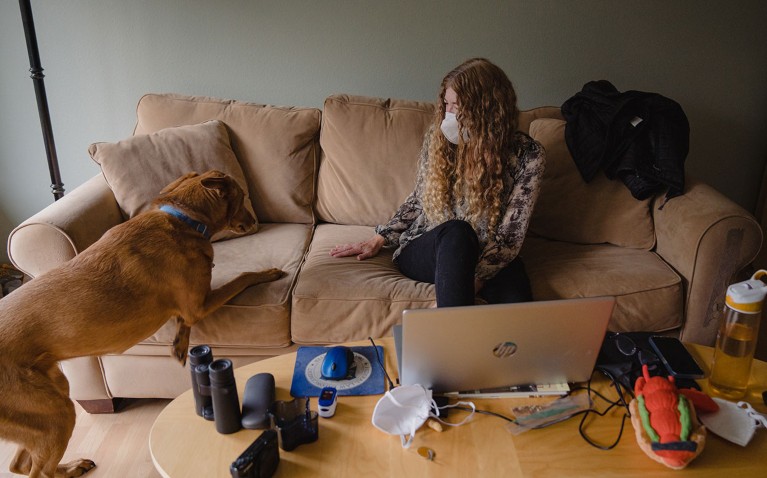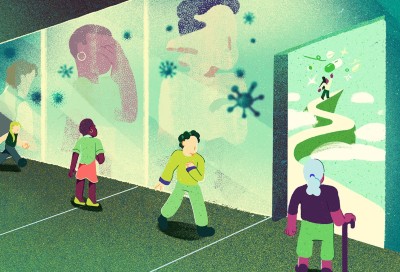Long COVID is characterized by symptoms such as fatigue and brain fog, which can persist for months or years after SARS-CoV-2 infection.Credit: Jovelle Tamayo/The Washington Post via Getty
Researchers have developed a computational model that predicts how likely a person is to develop long COVID, based on an analysis of more than 6,500 proteins found in blood.
In a study published on 18 January in Science1, the team compared blood samples from people who tested positive for COVID-19 with ones from healthy adults, and found notable differences in the composition of proteins in people with long COVID, those who recovered and those who were never infected.

Long COVID research risks losing momentum — we need a moonshot
The analysis suggests that proteins involved in immune responses, blood clotting and inflammation could be key biomarkers in diagnosing and monitoring long COVID, which affects an estimated 65 million people worldwide.
The condition has been linked to more than 200 symptoms, including brain fog, fatigue, chest pain and breathlessness, which can persist for months or years after a SARS-CoV-2 infection.
The small study “will hopefully pave the way for further studies to try and develop therapies for what is, at the moment, pretty much an impossible thing to treat”, says Aran Singanayagam, a respiratory physician at Imperial College London.
Protein patterns
The study included 39 healthy adults who had never tested positive for COVID-19 and 113 people who had, of which 40 had long COVID, defined as having symptoms persist six months after their initial infection. Of those, 22 still had symptoms 12 months after first testing positive.
The researchers analysed 6,596 proteins across 268 blood samples, which were collected from participants, once during the acute phase and again six months after. They found several differences in the blood of people with long COVID compared with those without it, including an imbalance in proteins involved in blood clotting and inflammation.
Compared with healthy participants and those who had fully recovered from COVID-19, people with long COVID had lower levels of a protein called antithrombin III, which helps to prevent blood clots, and higher levels of the proteins thrombospondin-1 and von Willebrand factor, both of which are associated with clot formation.

Long-COVID treatments: why the world is still waiting
When they examined blood cells from a subset of participants, the researchers found that the expression of a protein called CD41 on white blood cells was lowest in healthy people and highest in people who had 12-month long COVID.
CD41 is typically found on platelets — cell fragments involved in clotting — and its presence on white blood cells indicates abnormal clumping of these cells. “That could contribute to microclots,” says Lisa Chakrabarti, an immunovirologist at the Pasteur Institute in Paris. Some scientists think that these tiny blood clots could be the cause of some long COVID symptoms by blocking oxygen flow to tissues.
The researchers also found increased activation of the complement system — part of the body’s immune defences which normally help in clearing infections — in people with long COVID, both during initial infection and six months later. People with long six-month long COVID had reduced levels of some proteins involved in the complement system and elevated levels of others, compared with fully recovered or healthy participants. An imbalance of these proteins could cause tissue damage, says study co-author Carlo Cervia-Hasler, a physician–scientist at the University of Zurich, Switzerland.
Using machine learning, the researchers then created a model to predict whether a participant would develop long COVID on the basis of the protein levels in their blood, along with other factors such as age and body mass index. When applied to a separate data set, the model performed well in predicting which participants would have 12-month long COVID.
‘We are at the beginning’
Some of the team’s findings fit well with existing theories on the causes of long COVID, and “could open up new research regarding [therapies] that could help”, says Cervia-Hasler.
But the analysis involved only a relatively small number of participants, and it does not pinpoint the root cause of the condition, which has been a key barrier to developing treatments. “We are at the beginning of the exploration of this emerging field,” says Chakrabarti.
Singanayagam adds that, because long COVID involves such a range of symptoms, there are likely to be several underlying causes that affect people differently. “The heterogeneity of the syndrome probably means that bigger studies are needed,” he says. “It isn’t going to be a single mechanism underlying all of these symptoms.”